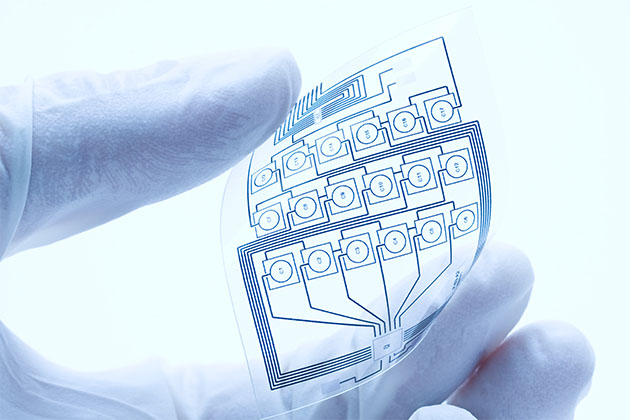Verkfræðingar hafa fundið upp hálfleiðara úr þunnu sveigjanlegu blendingsefni sem hægt er að nota fyrir skjái á rafeindatækjum í náinni framtíð.
Engineers at large corporations have been eyeing to design a foldable and flexible display screen for electronic tæki like computers and mobile phones. The goal is a display screen which would feel like a paper i.e. be bendable but also function electronically. Samsung, one of the largest mobile phone manufacturers in the world will in all probability be launching a flexible mobile phone very soon. They have developed a flexible lífræn light emitting diode (OLED) panel which has an unbreakable surface. It is lightweight but tough and robust and can withstand high temperatures. Its most remarkable feature would be that this display will not break or be damaged if the device falls – the biggest challenge faced today by mobile phone display designers. A regular LCD screen continues to display even when bent but the liquid inside it becomes misaligned and hence a distorted image is displayed. The new flexible OLED screen could be bent or curved without distorting the display, however, it still won’t be completely foldable. The flexibility can be further increased by using more flexible nanowires in the future. A quantum dot light emitting diode display is more flexible because of the use of nano-crystals to produce high-quality sharp light. The displays still have to be encapsulated into glass or other material for protection.
Nýtt efni til að smíða sveigjanlega skjái
Í nýlegri rannsókn sem birt var í Advanced Materials engineers from The Australian National University (ANU) have for the first time developed a semiconductor made from lífræn and inorganic material which efficiently converts electricity into light. This semiconductor is ultra-thin and very flexible making it unique. The lífræn part of the device, an important part of the semiconductor has a thickness of only one atom. The inorganic part is also small, about two atoms thick. The material was constructed by a process called ‘chemical vapor deposition’, similar to building a 3-dimensional structure from a 2D description. The semiconductor cannot be seen with naked eye, it rests between gold electrodes on a chip of size 1cm x 1cm having a functional transistor. One such chip can hold thousands of transistor circuits. The electrode serves as electricity input and output point. Once constructed opto-electronic and electrical properties of the material were characterized. This hybrid structure of lífræn and inorganic components converts electricity into light which then provides display on mobile phones, televisions and other devices. The light emission is seen to be sharper and better for higher-resolution displays.
Slíkt efni er hægt að nota í náinni framtíð til að gera tæki sveigjanleg - til dæmis farsíma. Skemmdir á skjá eða skjá eru mjög algengar í farsímum og getur þetta efni komið til bjargar. Þar sem vinsældir og eftirspurn snjallsíma með stærri skjáum fer vaxandi, er þörf klukkutímans að hafa endingu þannig að skjárinn sé ekki viðkvæmur fyrir rispum eða brotum eða falli o.s.frv. algjörlega úr sílikoni. Þetta efni væri hægt að nota til að smíða skjái fyrir farsíma, sjónvarp, stafrænar leikjatölvur o.s.frv. og kannski smíða tölvur einn daginn og eða gera farsíma jafn sterkan og ofurtölvu. Vísindamenn vinna nú þegar að því að framleiða þennan hálfleiðara í stærri skala svo hægt sé að markaðssetja hann.
Að takast á við rafeindaúrgang
It is estimated that 2018 will be produce a total of almost 50 million tons of electronic waste (e-waste) and very limited quantity would be recycled. E-waste constitutes electronic devices and equipment which have reached the end of their life and need to be discarded including old computers, office or entertainment electronic equipment, mobile phones, television etc. Massive amount of e-waste is a huge threat to the environment and is bound to cause irreversible damage to our natural resources and surroundings. This discovery is a starting point for designing electronic devices exhibiting high performance but which are made from lífræn ‘bio’ materials. If mobile phones were made of a flexible material they would be easier to recycle. This will cut down on e-waste generated annually across the globe.
Framtíð samanbrjótanlegra og sveigjanlegra raftækja á eftir að verða mjög spennandi. Verkfræðingar eru nú þegar að hugsa um rúllanlega skjái þar sem hægt er að rúlla tækjum upp eins og rollu. Fullkomnasta tegund skjás væri sem getur brotið saman, sveigð eða jafnvel mulið eins og pappír en getur haldið áfram að sýna snyrtilegar myndir. Annað svið er notkun á „auka“ efnum sem verða þykkari þegar þau eru teygð og sem geta tekið á sig mikla orkuáhrif og sjálfstillt sig til að leiðrétta hvers kyns röskun. Slík tæki væru létt en samt sveigjanleg.
***
{Þú getur lesið upprunalegu rannsóknarritgerðina með því að smella á DOI hlekkinn sem gefinn er upp hér að neðan á listanum yfir tilvitnaðar heimildir}
Heimildir)
Sharma A o.fl. 2018. Skilvirk og lagaháð örvunardæling yfir atómþunna lífræn-ólífræna gerð-I heterostructures. Advanced Materials. 30 (40).
https://doi.org/10.1002/adma.201803986
***






































